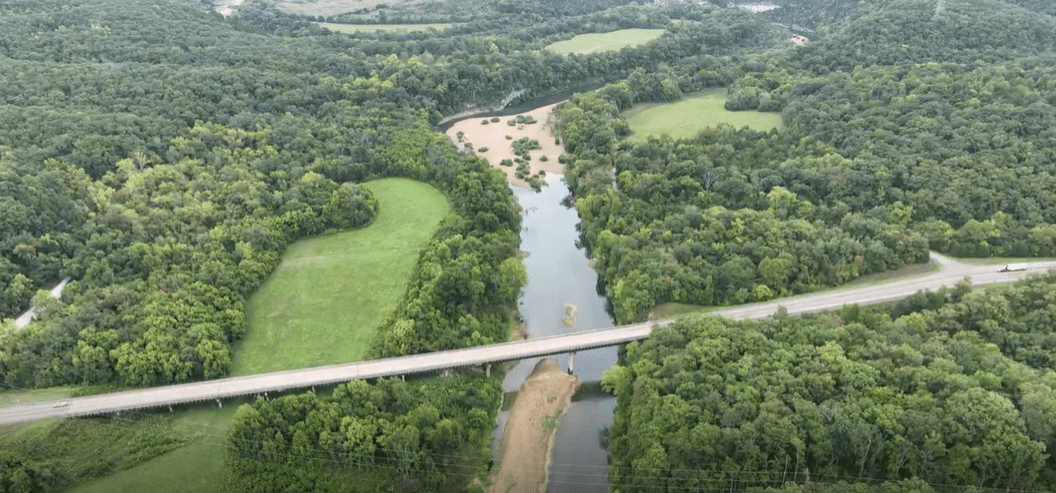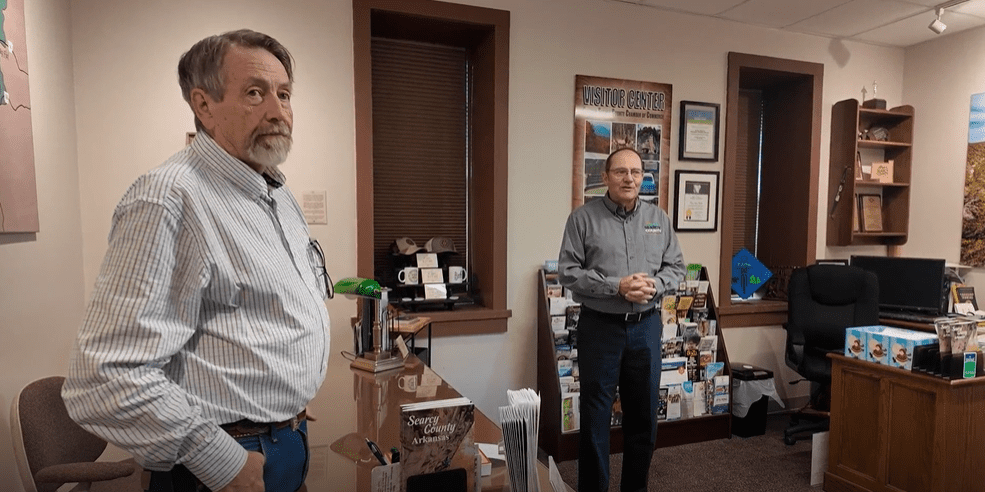Rural living is becoming increasingly attractive across the nation. The statistics show that 66% of Americans would consider moving to a rural area if telecommuting were an option. Searcy County, Arkansas, stands out as a top destination. As the only rural county in Arkansas with net population growth over the last decade, it draws new residents with its natural beauty, strong community spirit, entrepreneurial culture, affordable housing, and expanding broadband for remote work.
Communities Unlimited (CU) supports this trend through its “Relocation Rural” initiative, showcasing success stories like Searcy County, located in the north-central part of the Natural State. Despite decades of poverty and population decline, the Greater Searcy County Chamber of Commerce, led by Executive Director Darryl Treat, shifted the narrative 12 years ago by focusing on the county’s strengths, particularly through social media.
“I joined the Chamber 12 years ago, and we had to address the challenges of being one of Arkansas’s poorest counties with a declining population,” Treat said. “We chose to accentuate the positives.”
With nearly 8,000 residents, the Chamber’s efforts have boosted local pride, encouraged residents to stay, and drawn back those who had left. This positive messaging, combined with the rise of remote work, has made Searcy County an appealing choice for newcomers.
The Chamber’s collaboration with local governments has been key to these successes. “Our alignment with local governments is one of our biggest advantages,” Treat said.
Searcy County is not just about scenic views and essential services — it’s also a hub for entrepreneurs, with local businesses ranging from healthcare to retail. Visitors and residents enjoy cabins, local dining, and outdoor activities on the Buffalo National River. The county’s diverse economy includes timber, manufacturing, and more.
With a low cost of living, supportive schools, and a close-knit community, Searcy County offers an appealing lifestyle. The Buffalo River, which drew 1.5 million visitors in 2023, further highlights the area’s appeal. Searcy County’s success is a testament to the potential for growth and renewal in rural America, and CU proudly supports these efforts.
In Part 2 of this series, we delve into how Searcy County harnessed the power of social media to reshape its future, offering a compelling model for rural communities across the country.
Searcy County Part 2:
In recent years, Searcy County has emerged as a shining example of rural renewal. Located in the heart of the Ozarks and home to the Buffalo National River, the county’s natural beauty has always been a draw. But more recently, through intentional community engagement, Searcy County has attracted both former residents and newcomers.
Much of this success is attributed to the leadership of Darryl Treat, Executive Director of the Greater Searcy County Chamber of Commerce, who has been instrumental in fostering a sense of pride within the county while reaching out to those who might consider moving back to their hometown or making it their new home.
“We are proud of the progress we’ve made here in the county with regard to changing the spirit of the county, helping the county have a more positive outlook on itself. When I took over my position, I wanted local people to feel good about themselves, and I also wanted them to stay here because a lot of people in rural America, especially young people, move away for better opportunities. We wanted to retain our local people and make them feel good about the future. We also wanted those who left to think about returning, and for outsiders to see the value in moving here.”
— Darryl Treat, Executive Director of the Greater Searcy County Chamber of Commerce
When Treat first took the helm, the Chamber had a modest social media following and minimal online presence. Realizing the potential of social media to connect people locally and nationally, Treat launched a robust campaign to promote Searcy County’s strengths, focusing on its natural beauty, community spirit, and economic opportunities. The results were remarkable — what began as a Facebook page with just over 500 followers has since ballooned to over 17,000.
“God’s creation is all around us, and you don’t have to look very far before you find something beautiful to take a picture of and post on Facebook,” Treat said. This social media push, paired with stunning photography of Searcy County and regular updates on community events, has drawn interest from both locals and newcomers.
The Buffalo National River plays a central role in this appeal. The river is not just a tourist destination but also a symbol of the natural beauty that makes Searcy County special.
“The Buffalo River and the Ozarks have always been a draw,” Treat said. “But our goal was to show people that this isn’t just a place to visit — it’s a place to live.”

As the social media campaign gained momentum, the Chamber also worked to organize community events and improve communication across the county.
“Before I took over as Director of the Chamber, Searcy County had good things going on,” Treat said. “But it wasn’t organized. People in one part of the county had no idea what was happening in other parts. So, we applied organization countywide — border to border.”
This effort led to the discovery and promotion of activities that had been under the radar, such as rock climbing and whitewater kayaking on Falling Water Creek. These lesser-known attractions have since become part of the county’s broader tourism strategy, helping to draw more visitors and, in some cases, new residents.
Bob King, Director of the Buffalo River Historic Jail and Museum, has seen firsthand how these efforts have changed the county’s trajectory.
"There’s been a lot of people here working really hard. We are very fortunate to still have a core of people who love this place and want it to survive and eventually prosper."
— Bob King, Director of the Buffalo River Historic Jail & Museum
King, a lifelong resident of Searcy County whose family has lived there since the 1840s, understands the value of preserving the county’s heritage while also embracing change.
“It’s been a long struggle, but it’s very rewarding to finally see all your efforts come to fruition,” King reflected. “A lot of places may have some growth, but it’s coming at a price. So far, we’ve done a good job of managing healthy growth.”
The positive impact of these efforts can be seen in the county’s population statistics. Searcy County is the only rural county in Arkansas that had net positive population growth for both the 2010-2019 and 2020-2021 timeframes. While many rural areas are facing population decline, Searcy County is bucking the trend, proving that rural communities can thrive by focusing on their unique assets.
A large part of this success is due to the collaboration between local residents, businesses, and organizations. Treat credits the county’s businesses for playing a key role in this transformation.
“First off, credit goes to the businesses,” he said. “We’re the promoters, but they do the work. You don’t have a community unless you have businesses.” The Chamber now supports 317 members, a significant increase from the 52 members when Treat first took over.

Local business owner Kenda Dearing, who operates the Kenda Drive-In Theater with her husband in the county seat of Marshall, has witnessed this shift firsthand.
“Our business was predominantly locals for at least the first 20 years,” Dearing said. “Now we pull from a much larger radius.” As one of only two drive-in theaters in Arkansas, the Kenda Drive-In has become a regional attraction, drawing people from across the state and beyond.
Dearing, a retired schoolteacher who taught in Marshall for 33 years, sees the same resurgence in the county’s population echoed by other local business owners.
"People are wanting to get out of the cities and move. We have a lot of people who have moved here to take advantage of Searcy County and raise their kids in a more rural environment."
— Kenda Dearing, Co-Owner of Kenda Drive-In
For many, this move represents not just a change of scenery but a return to a simpler, more connected way of life.
“Beautiful land, beautiful area, combined with great people,” Dearing said. “It’s home to me.”
The growing population is more than just a win for the county; it’s a lifeline for local businesses and institutions. King points out that the community’s efforts to promote Searcy County are paying off in tangible ways.
“We are offering a product that a lot of people find very desirable,” he said, reflecting on the steady influx of new residents and visitors. “We’ve done a good job of getting the word out, and people are finding us.”
Despite the progress, Treat acknowledges that challenges remain. While tourism has been a driving force behind the county’s growth, more work is needed to create sustainable, long-term economic opportunities for residents.
“We’ve capitalized on tourism, but we need to do more to lift people out of poverty,” Treat said. One of the Chamber’s key goals moving forward is to bring in new industries that can provide jobs and economic stability for the county’s residents.
One such opportunity is already on the horizon, as a new industry is poised to move into Marshall, marking what could be the county’s most significant economic development in the past 60 years. On April 9, 2024, U.S. Secretary of Commerce Gina Raimondo announced that the Department’s Economic Development Administration (EDA) awarded a $1.7 million grant to the Searcy County Government to support manufacturing business growth. This grant will fund the renovation of a building in Marshall to establish a frozen foods manufacturing facility, a development expected to create jobs and boost the local economy.
“We’re working hard to bring this across the finish line,” Treat said, hopeful that this new facility will provide the jobs and stability the county needs to continue its growth.
As Searcy County continues to evolve, there is a sense of optimism among local leaders and residents alike.
“I think we’ve only scratched the surface of our success,” King said. “We’ve got so many good projects we’re going to be announcing here very soon, and I am just thrilled. On a scale from 1-10, yeah, turn it up to eleven on my optimism.”
For Treat, the work is far from over, but the progress so far has been incredibly rewarding.
“Bob and I are longtime Searcy County people, and this is our home. We get the chance to leave a legacy here, and that’s a rare opportunity.”
— Darryl Treat
Searcy County’s journey from a dying rural area to a developing community offers a model for other Persistent Poverty Counties looking to chart a new path forward.


